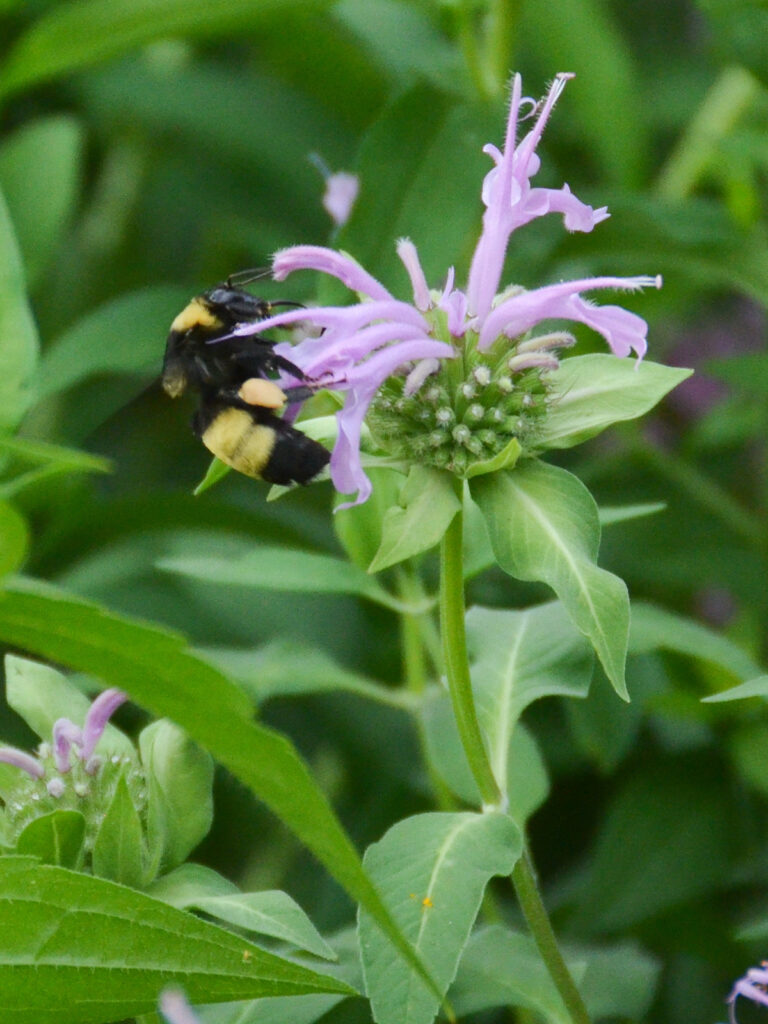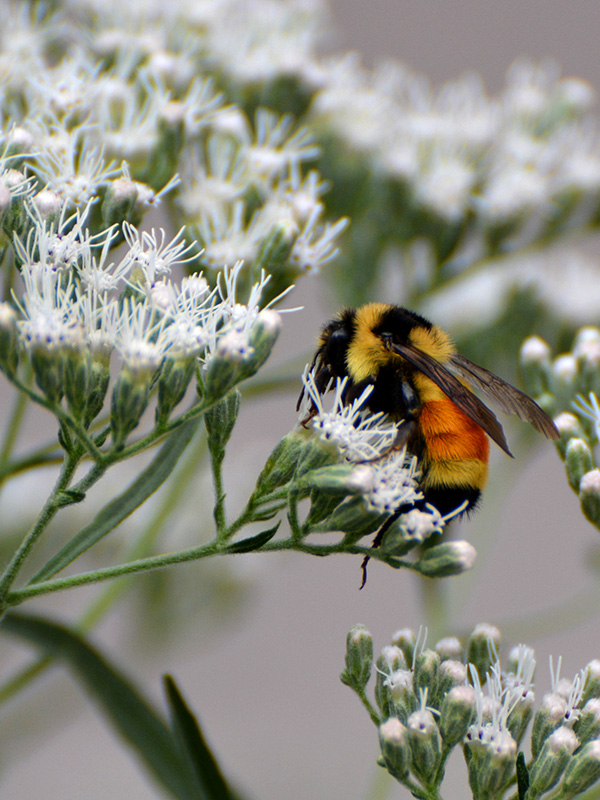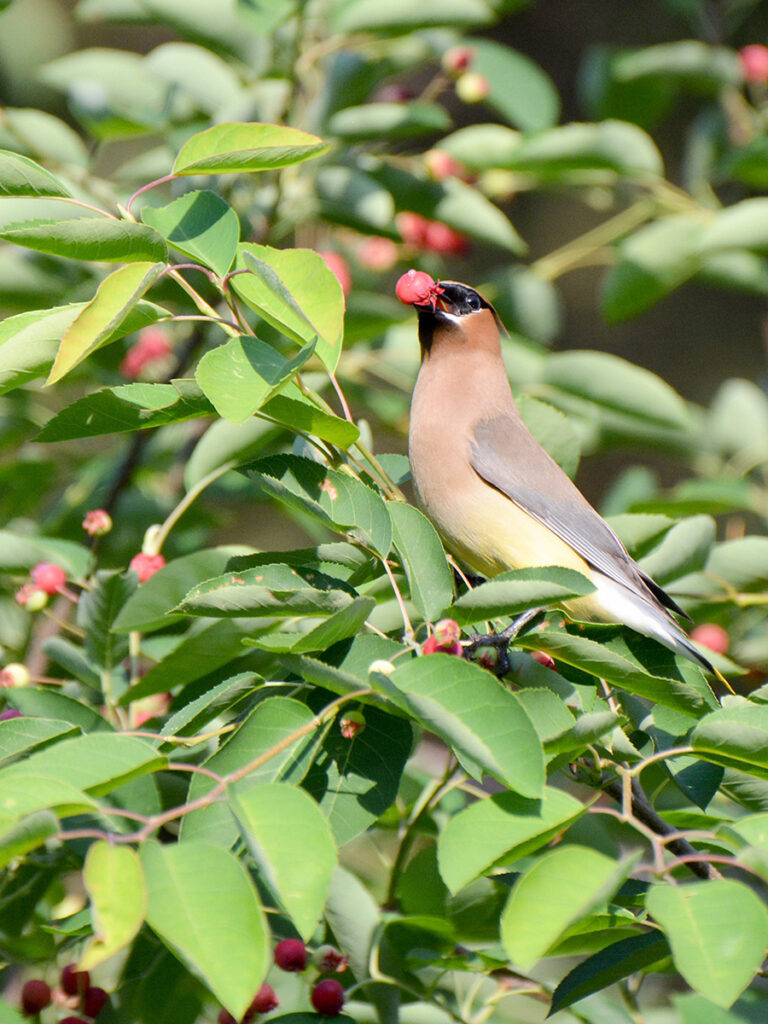We can’t in our own yard directly provide habitat for the world’s large creatures, but we can provide a sanctuary for native bees — some of the most important creatures in the world.

Society-level practices (pesticides, loss of habitat, etc.) are responsible for the decline of bees and other pollinators, but it’s exciting to see that we’ve been able to make a difference even in our smallish yard.
We were especially happy to see the beautiful, large bumble bee: the black-and-gold bumble bee (Bombus auricomus), here nectaring on one of its favorite plants, Monarda fistulosa (also mentioned as a favorite in Pollinator Pathway!)

A new-to-us discovery in 2022 was this tricolored bumblebee. At first, I thought I had discovered the rare rusty-patched bumblebee, but even though this tricolored bumble isn’t endangered it was still exciting to see. I hope it returns in the future!
The busy buzzy-ness of a multitude of bees adds so much to our yard!
It’s nice to know that when we provide habitat for our native bees, many other creatures (especially butterflies) benefit, too.
And where would all the animals who rely on fruits, nuts, and berries be without native bees to pollinate these plants?
An amazing 75%-80% of plants in the wild require pollination, often by wildlife. (Some are dispersed by wind or water.)

Here are the pages about bees
The first thing people wonder is “WHY create habitat for bees?”
The second is “Aren’t they too dangerous to have in our yards and in our communities? They might sting! They might even sting (gasp) a child!!”
For many reasons, we’re doing all we can for these native pollinators by providing:
- food: in spring, in summer with woodies and herbaceous plants, and in fall, including goldenrods
- cover
- places to raise young, including bare ground, bee houses, as well as snags, logs, and other areas for wood-nesting bees.
Then there are all those other bees, including those such as carpenter bees or wasps and hornets.
BUT what about those non-native honey bees?
Other ways we help bees
- have a pesticide-free yard, and
- participate in citizen science projects.
Resources
- Cornell Lab:
- National Wildlife Federation:
- 5 facts about bumble bees — and how to help them
- Native Plant Finder – EXCELLENT! Includes plants for specialist bees
- Keystone native plants for Ecoregion 8 – includes most of US east of Mississippi
- David Suzuki Foundation:
- How to tell bees from wasps from flies – A series of easy, short questions
- National Geographic:
- VIDEO: How to train a bumblebee: Scientists study insect intelligence (2 min.)
- Sharp-Eatman Guides:
- Wild bees of NY – GORGEOUS photos!
- Picture Index of bees – Scroll through to find the bee you’ve seen sorted by size
- Heather Holm and Desiree Narango:
- Soft landings; Keystone species – a PDF of two graphics in one file
- Joe Gardener (of Growing a Greener World PBS show):
- All about native bees with Heather Holm – article and podcast
- Natural Resources Defense Council (NRDC):
- Mother Jones:
- Grow Native Massachusetts:
- VIDEO: More than just the buzz: Finding real solutions to native pollinator decline – Dr. Gegear reminds us that we need to protect the pollinators – EXCELLENT!
- Tufts Pollinator Initiative:
- Four ways your garden can support more pollinators – some principles and a “Plant this, not that” kind of list – can be used as a handout
- The Xerces Society:
- Who are the pollinators – info on various insects
- Buying bee-safe plants
- Pollinator Protection Pledge – then you’re eligible to buy a beautiful pollinator sign
- Conserving Bumble Bees
- Bumble bee conservation brochure – Excellent!
- Where do bumble bee queens overwinter
- How to create habitat for stem-nesting bees
- Five ways to support queen bumble bees this spring
- Pollinator-friendly Parks
- VIDEO: Beyond plants: What else do insects need to thrive
- Pollinator Resource Center for all ecoregions and for the Great Lakes region (for CNY)
- BOOK: Attracting Native Pollinators — very complete and user-friendly
- Protecting bees from neonicotinoids in your garden
- How neonicotinoids can kill bees
- Buying bee-safe plants
- Searchable systemic insecticides reference
- No-Mow May (BeeCity USA is sponsored by Xerces)
- Pollination Guelph (in Canada):
- Pollinator resources and information – newsletter, videos, links to info etc – Excellent!
- BBC News:
- BBC Future:
- Pollinator Pathway:
- Pollinator Pathways – establishing pollinator-friendly habitats
- VIDEO: Sarah Bergmann’s TED talk on pollinator pathway
- NYS DEC’s Pollinator Pathway brochure
- Pollinator Partnership:
- Scientific American:
- Audubon:
- PBS Nature:
- VIDEO: My garden of a thousand bees – Excellent videography and insightful commentary; NOTE: Since this was filmed in the UK, it includes [from our perspective] “non-native” plants and insects
- Yale Environment 360:
- Backyard battle: Helping native bees thrive in a honeybee world – includes Buzz Kill, a 15-minute video. Excellent!
- Urban refuge: How cities can help rebuild declining bee populations
- Ecological Landscaping Alliance:
- Re-Introducing Hedgerows to Residential Landscapes: We need some “messy” spots!
- Joe Gardener (of Growing a Greener World PBS series):
- EcoBeneficial:
- BOOK – The Pollinator Victory Garden: Win the War on Pollinator Decline with Ecological Gardening by Kim Eierman, Founder of EcoBeneficial
- EcoBeneficial’s Pollinator Victory Garden list of links to more information
- Maine Cooperative Extension:
- Understanding native bees, the great pollinators: Ideas apply to other areas, too.
- Friends of the Earth Canada:
- A flower patch for the Rusty Patched bumble bee – A great guide that is NOT just for the Rusty Patched bee! NOTE: This is about Toronto – The concepts apply most anywhere, but adapt using your own native species
- AAAS Science:
- LBJ Wildflower Center:
- The Scenic Route — Roadsides provide critical habitat
- Cornell Danforth Lab:
- The Guardian:
- USDA Forest Service:
- Gardening for Pollinators – some general principles
- Attracting pollinators to your garden using native plants – booklet for the Northeast
- PennState Extension:
- Planting pollinator-friendly gardens – general principles, applicable to most areas.
- Beyond Pesticides:
- Jessecology:
- Reuters:
- Bees in the Netherlands trained to detect Covid infections – Bees detect volatiles with a sensitivity of parts per trillion. Bees, like dogs, can learn to detect volatiles and odors, but with just a few minutes of training.
Reflections
Bees are not optional.
~ Sam Droege, scientist at USGS
See his amazing photos!
Keeping honey bees to ‘save the bees’ is like raising chickens to save birds.
~ Scott Black, Ex. Dir., Xerces Society for Invertebrate Conservation
Four factors — the loss and fragmentation of habitat, the degradation of remaining habitat, pesticide poisoning, and the spread of diseases and parasites — account for most of the declines in populations of bees and other pollinators. These factors have complex political, economic, and social origins that are not easily addressed.
At the local level, however, the solutions to many of these problems are simple and straightforward. Many insects are fairly resilient, and there are actions we can take in our own backyards and neighborhoods, on farms and ranches, and in city parks and wild areas, to help strengthen and support pollinator populations.
~ Xerces Society, Attracting Native Pollinators, p. 14
Excerpts (below) from a poem by Matthew Olzmann —
The following is just a teaser; please read the entire poem!
Letter to Someone Living Fifty Years from Now
Most likely, you think we hated the elephant,
the golden oak, the thylacine and all variations of whale harpooned or hacked into extinction.
…
You probably doubt that we were capable of joy, but I assure you we were.
…
There were bees back then, and they pollinated
a euphoria of flowers so we might
contemplate the great mysteries and finally ask,
“Hey guys, what’s transcendence?”
And then all the bees were dead.
